Products are carefully selected and evaluated. If you buy through a link we may earn commission.
For this episode of which running shoe is right for you we are pitting two of the biggest names in the shoe world against each other: Nike vs Saucony Running Shoes. While many of you are just looking for the Alphafly vs Endorphin elite comparison, we’re going to break it all down.

Both brands have things people love and things people dislike.
One of the things they share is that both tend to run a bit more narrow than other brands.
Right now, Nike is having a moment with their super shoes, but Saucony is riding high with their daily trainers. Let’s take a look at comparable models, fit and features to find your next shoe.
When it comes to these two brands, I think it’s key to know that both have continued to change an adapt. So if you’ve tried one previously without luck, you might need to be willing to test a new model.
Main Differences Saucony vs Nike
Nike and Saucony have a similar range of shoes, but a very different fit and feel. A lot of the difference comes down to the types of foam they are using and the depth of the Endorphin line that Saucony has started to really push.
I break down the differences in more detail below, but here’s a quick overview:
Saucony Running Shoes
- Often noted as fitting a more narrow foot, with a smaller toebox
- Wide range of heel drops from traditional 12mm to lower 4mm
- Well known for the casual shoes as well as their running shoes
- Focus is on lighter shoes that provide maximum comfort
- Has an ongoing Fit Tester program to continually update shoes
Nike Running Shoes
- More narrow fit, especially in the heel and midsole
- Tend to run smaller in width and length than many other brands
- A larger focus on newest and trendiest technology to “improve running economy”
- Known across a wide variety of sports and highly visible in competition
- Has a large brand loyal following
For many years I was not a fan of Nike, but about 7 years ago I discovered a Nike shoe that has become one of my go-to shoes. Then I started testing their carbon plate shoes and really wondered if anyone could catch up. On the flipside, Saucony has some of the shoes that I have loved for over a decade…so it’s a tough choice!
I’ve worn both brands and will add some personal thoughts, along with comparable models from each brand at the end.
How do you say Saucony?
Since I used to get this question a ton wearing my Kinvaras, let me help you out.
Sock-a-knee.
It’s actually named after a creek in Pennsylvania and their logo is to represent the flow of water! They really love places for shoe names. I got to visit the actual towns of Kinvara and Kilkenny in Ireland, just a few of their shoe names.
Saucony vs Nike Running Shoe Feature Comparison
Both brands have been around for a very long time and are leaders in running shoe design. They both offer various technologies to aid with comfort, support, stability, and cushion.
They differ in both fit and technology.
Here is a breakdown of each shoe based on the components buyers need to consider when purchasing a running shoe.
It’s gonna get a little TECHY…so you can just skip on down to the specific model comparison if you want, but personally if I’m shelling out $150 for shoes, I kinda want to know why.
Durability
The lifespan of shoes from both companies is fairly comparable. Though I kind of dislike that they give a 200 mile range, that’s massive. Assume that for heavier runners shoes breakdown faster and those running on the treadmill may get more life.
- Saucony states their shoes last around 400 miles, which is pretty average. The new Endorphin pro with the carbon fiber plate is more like a racing shoe and therefore only expected to last around 200 miles.
- Nike’s Vapor Fly is only going to give you about 200 miles, but most shoes are in the 300-500 mile range
Determining when to replace running shoes, of course, all depends on your gait, weight, and whether you run mostly on trail or road.
Breathability
This is a section I used to include, but honestly every single brand has made sure their shoes are breathable. They’re just coming at it from sligthly different technology or fabric.
So the higher end shoe is going to be even thinner on the upper than your daily trainer, but they’re both equal here.
Fit
Nike running shoes are often reported to run small.
Saucony shoes are often reported to run narrow, but not short in lengthy like you sometimes find with Nike.
NEITHER brand is good for a wider foot, unless you are buying a wide model. They do have some wide models, but the average shoe is going to be a little slimmer fit. Which also means they do not have a large toe box like an Altra Running shoe.
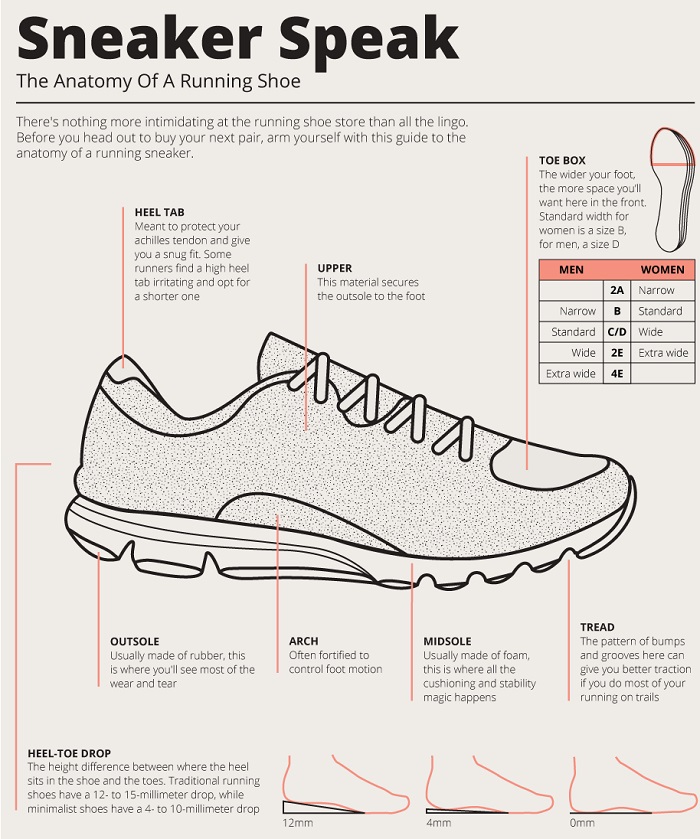 This is an older, yet still very USEFUL graphic from the Huffington Post.
This is an older, yet still very USEFUL graphic from the Huffington Post.
I forget we may not all know the lingo when talking about different components of the shoe and why they matter.
Cushioning
Saucony has transitioned most of their shoes to PWRRUN technology, which they promote as a better than the standard EVA foam used by most brands.
- PWRRUN+ midsole cushioning provides more flexibility, durability, and springiness in a foam that’s 25% lighter
- Again and again their focus comes back to lighter, flexible for more power in your take off and more energy return
Nike started putting air in their shoes back in 1977 to improve cushioning.
“Nike Air technology consists of pressurized air inside a tough yet flexible bag and provides more spring without compromising the structure.”
And since the 90’s they’ve been recycling waste material from production in to new shoes. They continue to look at this sustainability in developing new shoes.
Currently the React Foam is their big winner. It’s truly a great soft and light cushion.
Stability
Nike does say their stability shoes are slightly wider and also designed with a curve that will help with heel to toe transitions.
Saucony has also been transitioning to less aggressive stability tools, ensuring the shoe is not over correcting or doing the work for you.
They utilize a medial post (which is a device within the midsole that is firmer) to help provide control and a TPU heel plate which again makes the rides slightly firmer and adds control. Thanks to the cushioning, you don’t so much notice the stiffness and reap the benefits.
As you may know, I’m not a huge fan of stability shoes for most runners. I am not finding a big difference in brands, they are all focused on preventing that foot roll and often feel more rigid, even with a decent cushion.
Affordability
Saucony prices range between $100 to $170, while Nike start at a slightly higher price at $120 to $180.
The most popular models for both brands are priced toward the higher range. Carbon fiber shoes and often trail shoes will go beyond those rates, like the Alphafly which is over $250.
You’ll notice that every brand offers a range and this is indeed due to a difference in technology and where they sell the shoe. They know that the big box store can sell the shoe with less in it, while the local running store needs to be best for dedicated runners.
Nike Vs Saucony Running Shoe Models
Now that you know more about each brand, let’s look at their top models in each of the main categories. There’s no winner declared here because all are great shoes, it’s just about which one is best for your foot.
Did you notice I even said the brands in reverse order this time…seriously no favorites, I have run in both brands many different times over the years.
Quick note, I absolutely encourage you to checkout Nike’s return policy! It makes it much easier to test out a shoe and return if it doesn’t feel right.
Stability Running Shoe
Oddly from both brands this is one of the most affordable running shoes at under $100. As a reminder these shoes tend to be a little stiffer, so if you like the price know they may not feel as amazing on long runs.
👉React Air Zoom Winflow
Another shoe utilizing their great react cushion and the wrap around feel of the flyknit upper.
It has a slightly higher arch and more room in the toebox than most Nike running shoes.
This is what they call a stability neutral shoe, which is probably more in line with what I’d recommend. It’s not a firm and will not be over correcting your foot strike. It has guiderails as most stability shoes do, but without losing the softness.
- 10mm drop
- 10 oz women’s, 9.9 oz men’s
- $100
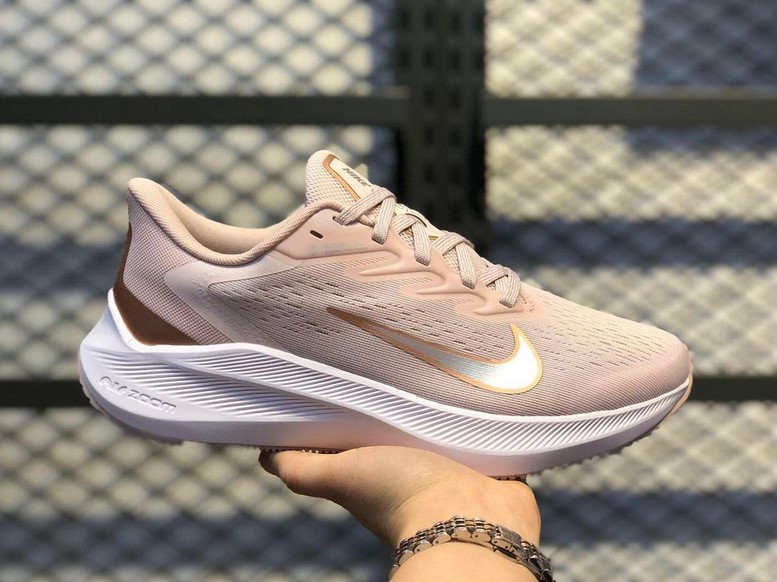
I couldn’t finish the stability shoe section without mentioning the newer style that Nike has started promoting. The Nike Invincible!
I recently tested version 3 and I’ve honestly never found a stability shoe with so much bounce. It’s definitely benefiting from using the same foam as the Vaporfly racing shoes.
While the shoe is still narrow, per normal Nike, it has a much wider base and therefore offers a lot of stability with that cushion. Plus an outsole with grip for going from road to trail.
👉Saucony Guide
In this model, Saucony not only paid attention to the support below, but uses the upper for additional stability. It wraps around your foot, helping you feel more secure in the shoe,.
And as noted their stability is there, but without being aggressive so you aren’t feeling it…it’s just working. Plus, the ride still feels cushioned which was something that many traditional stability shoes lacked. That’s my kind of shoe.
Checkout my comparison of the Saucony Ride vs Guide – two of their most popular shoes that are often confused for each other because of the similarities in fit and feel.

- 8mm drop
- 7.8 oz women’s, 8.8 oz men’s
- $140
Neutral Running Shoe
👉Nike Pegasus 40
The Nike Pegasus has all the bells and whistles that a runner could ask for: just the right amount of cushion in midsole for maximum comfort, durable rubber outsole to withstand, and a breathable mesh upper to keep your feet feeling fresh and dry.
But let’s get real for a second. The Nike Pegasus isn’t just a pretty shoe. It’s got substance too, with a firm heel counter that keeps your foot locked in place and a molded foam insole that provides extra support for those long runs.
I’m shocked it took me until version 40 to test out this shoe. It’s so clear why it’s a long time favorite for many.
This is a good option for your easy weekday runs or for the support of a marathon training run.
This is definitely a shoe that I like for those weekday training runs. Not over built, just enough cushion and a little roomier than other Nike’s.
The Nike ZoomX might be the most cushioned shoe they have, but it’s also a higher price point and a model I don’t know that will stick around as long. It’s never fun to find the shoe we love and then have it taken away.
👉Saucony Ride or Saucony Kinvara
These two are the most popular neutral running shoes from Saucony. Both have been around for many years and continued to improve.
What’s the difference in the Ride vs Kinvara?
- Cushioning is thinner on the Kinvara making it often more suitable for half marathon and under
- Kinvara is often seen as your tempo run or race shoe, the Ride your everyday training
The Ride is focused on cushioning and support, while the Kinvara is designed for a more natural and lightweight feel.
Saucony Ride
The ride is a great everyday trainer. I’ve used it a few times throughout the years.
It’s a great option for those who want a little more support for those longer runs. While not a stability shoe, it’s going to have the slightly higher heel drop and weigh just a bit more for the added cushion and support.
- 8mm drop
- 7.8 oz women’s, 8.8 oz men’s
- $140
Saucony Kinvara
This has been one of my go to shoe’s for many years. The newest model is starting to feel like a departure from what I loved in 2010, but it’s still a shoe that I’ll continue to wear.
The stack height has increased to add more cushion and stability to the run, but as you can see they are holding on to that lightweight and low drop. It’s hard to find low heel to toe drop shoes, so this is a big time winner.

Cushioned Running Shoe
👉React Infinity Run
Another shoe utilizing their great react cushion and the wrap around feel of the flyknit upper. It’s super similar to the Epic React that I loved running in for many years, except it’s a stability shoe.
The cushion just feels so freaking good and admittedly, I really like the look of this shoe. Plus it’s got great padding around the heel collar and tongue.
It has a slightly higher arch and more room in the toebox than most Nike running shoes. BUT I did find this shoe to run small, so it’s one where you might want to size up!
This is what they call a stability neutral shoe, which is probably more in line with what I’d recommend. It’s not a firm and will not be over correcting your foot strike. It has guiderails as most stability shoes do, but without losing the softness.
- 8mm drop
- 9.2 oz women’s, 10.7 oz men’s
- $165

👉Saucony Triumph
I’ve used the last few models of the Triumph for MANY training miles and definitely recommend.
The Saucony Triumph is known for its plush cushioning, which you can absolutely feel more than in the Saucony Ride. This provides a soft and comfortable ride for runners who prioritize cushioning and impact absorption. That being said, I still found the shoe to feel really stable on runs up to 16 miles (I wasn’t marathon training so didn’t go farther).
This is the shoe I would probably recommend for most distance runners as a go to trainer from Saucony.

Whether you’re heading out for a 5k or your 20-mile long run, this shoe provides the comfort and support you need, especially on the days when your legs are feeling it a bit more than usual.
Another bonus? It comes in 13 colors!
- 10 mm drop
- 8.8 oz women’s, 9.8 oz men’s
- Available in wide
- $150
Carbon Fiber Plate Shoes
Are they cool new technology, yes. Do they last as long as your other shoes nope.
I’ve run in both shoes and found they are a pretty great match up. The bounciness of the foam is there, the shoe does return energy and help roll you forward. Neither created any hot spots on the foot and you will find a equal number of fans for both shoes.
That being said if I were forced to pick, I would probably race in the Alphafly. Though the Endorphin Elite feels a bit more stable and I think might be more comfortable for a lot of runners.
👉Nike Alphafly 3
The shoe was designed to build on the success of the Nike Vaporfly and take things to the next level. Consider this the shoe you’d want for half marathon and marathon running because it’s much more stable, but still has a lot of bounce.
The Nike Alphafly features a number of updates and improvements over the Nike Vaporfly, including a thicker midsole and an additional carbon fiber plate. The shoe also features Nike’s latest foam technology, Nike ZoomX, which is designed to provide even greater cushioning and energy return than the ZoomX foam used in the Nike Vaporfly.
Checkout my complete Nike Alphafly 3 review >>
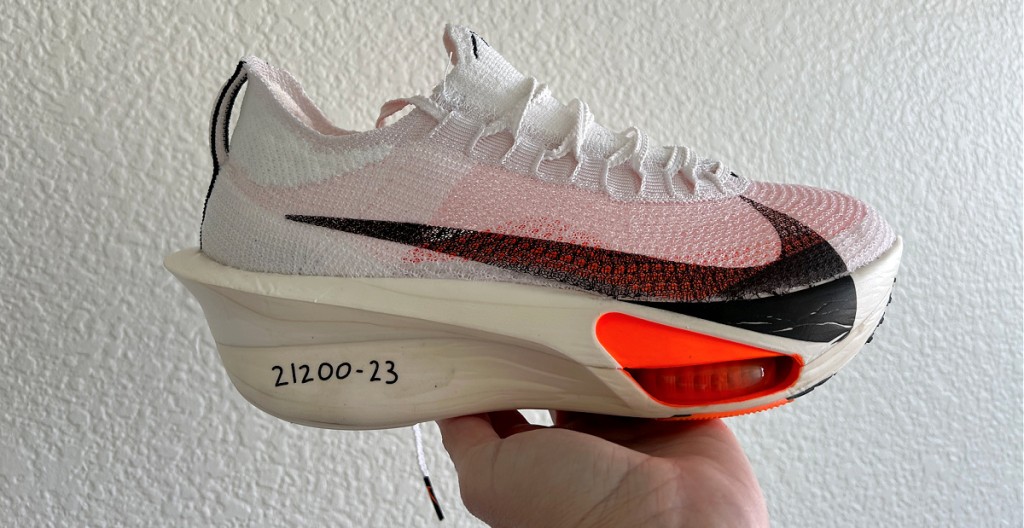
👉Saucony Endorphin Elite
I’ve run in the Endorphin pro for a few races, but the new Elite is taking carbon fiber to the next level for them. In modeling the success of Nike Alphafly, they are adding super lightweight foam and stack height. The goal is by combing the foam and the carbon fiber you get a ride that really propels you to go the distance with less fatigue.
I’m definitely loving this shoe for half to full marathon racing. They added a small bit of padding to the heel cup and I’m a BIG fan of this for preventing rubbing.
- Unisex
- 8 mm heel drop
- 8.1 oz
- $250

Trail Running Shoes
👉Nike Terra Kiger
Compared to many of the trail shoes I’ve run in this is a bit more minimal on the cushion side, and yet it’s a shoe I really like and have used for quite awhile.
While this shoe has a rockplate, I’d still relegate it to my mid-distance or faster trail style running, not my super big rock kind of days. I’m a big fan of the lower profile and the Epic react cushioning (see info below).
Some noted that they didn’t like the feel of the shoe on hard packed trails, but I can’t say I minded. Again simply knowing upfront that this is trail running shoe that’s going to be moderately cushioned and responsive.
The grip felt good in most places, though the lugs are not huge or varied on the forefoot, so for more technical terrain you might choose another option. I’ve heard it doesn’t grip well when wet, but I wasn’t on anything slick enough to find that as an issue.
the lugs are not huge or varied on the forefoot, so for more technical terrain you might choose another option. I’ve heard it doesn’t grip well when wet, but I wasn’t on anything slick enough to find that as an issue.
- Weight: 10.5 oz men’s, 8.8 oz women’s
- Heel drop: 4mm
- Available for $150
👉Saucony Peregrine
At one time this was indeed my favorite trail running shoe. They made some adjustments around version 5 or 6 and I just didn’t love it anymore, so I haven’t gone back.
But that has been a few years and I’m hearing the ISO and 12/13 versions are back on par with what we all previously loved. So let’s just say…there will probably be yet another purchase happening soon.

The Saucony Peregrine is a popular and versatile trail running shoe that has gained a strong reputation among trail runners and outdoor enthusiasts. Designed to handle a variety of terrains and conditions, the Peregrine combines responsiveness, durability, and traction to provide a reliable and enjoyable off-road running experience.
For me, I appreciate that it’s not one of the overbuilt trail shoes and the traction is fabulous. They have also taken some weight out of the updated models!
- 4mm heel drop
- 8.1 oz women’s, 9.2 oz men’s
- Available for $140
More about Saucony
Like another well known running brand (New Balance), Saucony started it’s first factory in 1898. And by 1910 they were making running spikes…but few people were running or even looking for running shoes, so it wasn’t until the 1970’s that they started to grow.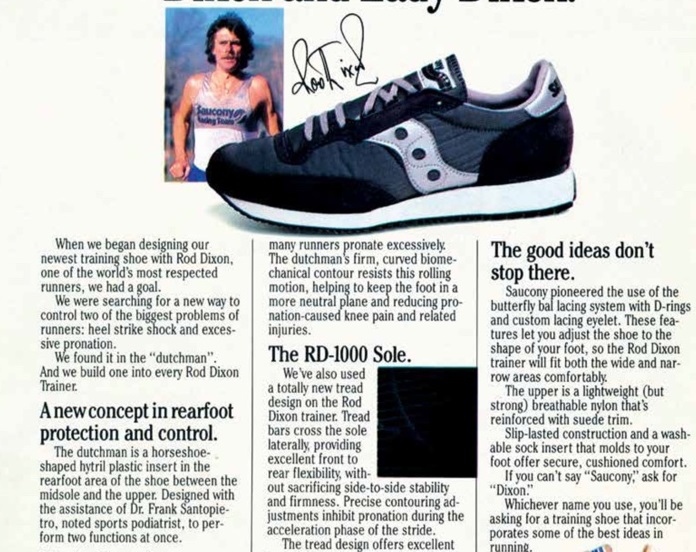
First they became known for their casual shoe with it’s cool style and then, the big time hit.
Runner’s World featured them in 1979 as a top 10 running shoe. By the 80’s they were making shoes with a non-slip sole which was a big innovation.
Then came 2009 and the Saucony Kinvara – this one shoe changed many things about their design and philosophy. It was the more natural running shoe (yes during the barefoot trend). The new goal became how to strip shoes down, without sacrificing cushion and comfort.
Good performance, good health and good community are their guiding principles. You may have seen their hashtag #runforgood – which is really about doing good, giving back and finding sustainable practices.
More About Nike Running
Is there anyone who doesn’t know the story of Nike yet?? The brand actually started in 1964 as Blue Ribbon Sports and didn’t take on the name of Nike the Greek Goddess until 1971.
If you haven’t read Shoe Dog by Phil Knight, it’s a wonderful book that gives you so much insight to the building of a company and a brand.
I fully understand not everyone loves Nike due to many of the practices we’ve seen with their athletes. I’m just here to provide details about the gear, you make those judgements.
In 1972, the Nike Waffle Racer was handed out at the Olympics and things really started to take off. One of these original pairs of shoes recently sold for almost $500,000!
From there they have continued to inovate and consistently produce new models of shoes for a variety of sports.
Nike has also dominated the marketing game.
How to Choose Nike or Saucony?
Nike and Saucony are two extremely well known running shoe brands, but more important than brand is the fit of the shoe.
Your gait and feet will change over time and you may need to change shoes.
This is also why I recommend rotating through several pairs of shoes at once.
And remember, just because these are two of the most well known brands on the market, there are still plenty of other shoe brands to select from if neither Saucony nor Nike has the right shoe for you.
Keep in mind that shoe design can change, even with the same model, so always assess how the shoe fits every time you replace a pair.
For more help selecting the right shoe for you, don’t worry, I’ve got you:
Other ways to connect with Amanda
Instagram Daily Fun: RunToTheFinish
Facebook Community Chatter: RunToTheFinish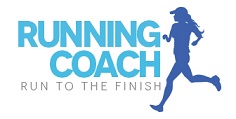
Sign Up to Receive a Weekly Newsletter with Top Running Tips and Laughs


